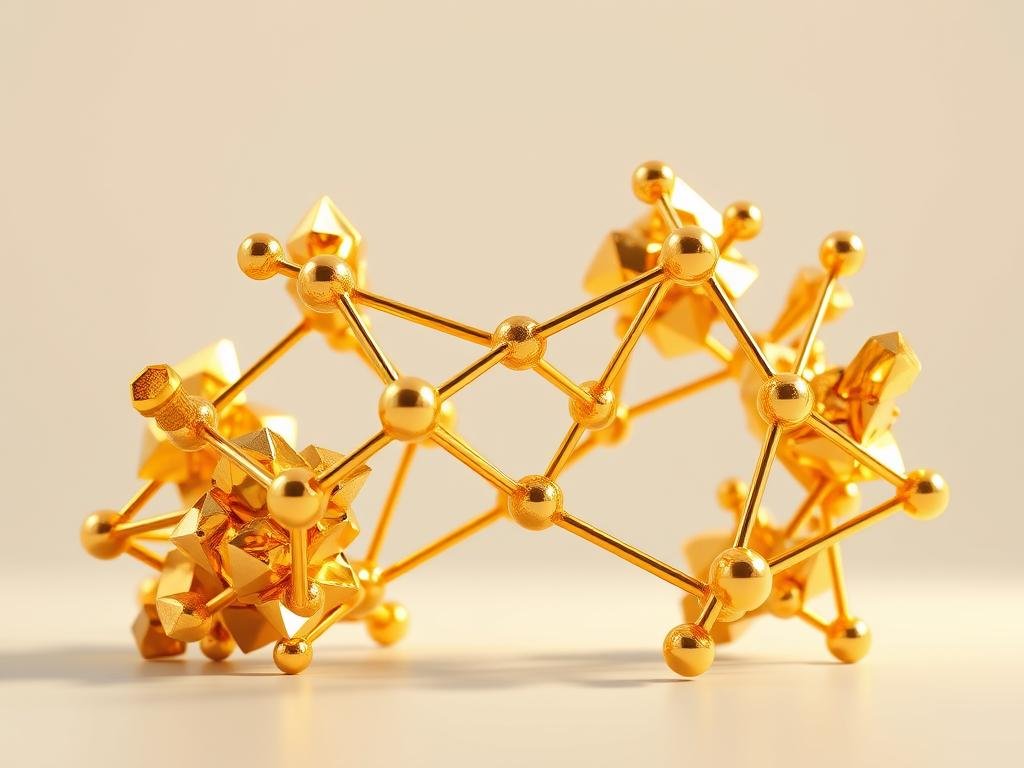Gold is renowned for its distinctive physical properties, one of which is its remarkable الكثافة. تميز هذه الخاصية عن المعادن الأخرى وتساهم في قيمتها وتعدد استخداماتها.
The significance of كثافة الذهب يظهر ذلك بوضوح في تطبيقاته المختلفة، من المجوهرات إلى الاستثمار. فهم هذه الخاصية ضروري لتقدير قيمتها التاريخية واستخداماتها الحديثة.
Among naturally occurring elements, ذهب stands out for its high density. The scientific principles behind measuring density and its relation to gold’s atomic structure will be explored in this article, providing a comprehensive understanding of this precious metal.
الكثافة الملحوظة للذهب
الذهب معروف بكثافته الاستثنائية، وهي سمة أسرت البشر لقرون. هذه الخاصية الرائعة تعتبر عاملاً رئيسياً في قيمة الذهب وتطبيقاته العديدة عبر مختلف الصناعات.
What Makes Gold So Heavy?
Gold’s high density is attributed to its atomic structure and the way its atoms are packed. With a density of 19.32 جرام لكل سنتيمتر مكعب، الذهب أكثر كثافة بشكل كبير من العديد من المواد الأخرى.
Gold Density in Numbers: 19.32 g/cm³
The density of gold is approximately 19,300 kilograms per cubic meter, or 0.7 pounds per cubic inch. To put this into perspective, a 1-kilogram gold bar is much smaller than a 1-kilogram aluminum bar due to gold’s high density. Gold’s density is also used to verify its authenticity and purity in various industries.
مقارنة كثافة الذهب بمواد أخرى: الماء لديه كثافة 1 جم/سم³، الرصاص 11.35 جم/سم³، والبلاتين 21.45 جم/سم³. توضح هذه المقارنات الخصائص الفريدة للذهب وكيف تؤثر كثافته على علاقة حجمه ووزنه.
العلم وراء الكثافة العالية للذهب
Understanding the science behind gold’s density requires a dive into its crystalline structure and atomic arrangement. Gold’s high density is primarily attributed to its face-centered cubic (FCC) crystal structure, where atoms are closely packed, minimizing empty space and maximizing mass per unit volume.

Atomic Structure and Mass
التركيب الذري للذهب يلعب دورًا حاسمًا في كثافته. برقم ذري 79، للذهب كتلة كبيرة. الهيكل FCC يسمح بتعبئة فعالة لذرات الذهب، مما يساهم في كثافتها العالية البالغة 19.32 جم/سم³. هذا الترتيب يتيح كتلة عالية لكل وحدة حجم، مما يجعل الذهب أحد أكثر المعادن كثافة.
"كثافة الذهب هي نتيجة مباشرة لكتلته الذرية والتعبئة الفعالة لذراته"، كما لاحظ علماء المواد.
Crystal Structure and Atomic Packing
يحقق الهيكل البلوري FCC للذهب كفاءة مساحة تقريبية تبلغ 74%، مما يقلل من المساحة الفارغة بين الذرات. يُوصف هذا التعبئة شبه المثالية بمعامل التعبئة الذرية. يرتبط رقم التنسيق البالغ 12 في الهيكل البلوري للذهب بكثافته ومرونته. مقارنةً مع المعادن الأخرى ذات الهياكل البلورية المختلفة، تؤدي ترتيب FCC للذهب إلى كثافة أعلى.
The interatomic bonding in gold’s crystal structure also contributes to its characteristic malleability and high density, making it a unique material for various applications.
Measuring and Calculating Gold Density
Gold density measurement is a critical aspect of assessing its purity and quality. To calculate gold’s density, one must divide its mass by its volume. This fundamental principle is applied by measuring the mass in grams or kilograms and the volume in cubic centimeters or cubic meters.
Methods for Determining Gold Density
There are several methods to determine gold density, with one of the most historical and significant being the Archimedes’ Principle. This principle revolutionized the way materials, including gold, were authenticated by providing a straightforward method to calculate density.
The Archimedes’ Principle involves measuring the volume of water displaced by a gold sample, which is equal to the volume of the sample itself. By comparing the weight of the gold in air to its weight when submerged in water, one can calculate its density.
The Archimedes Principle and Water Displacement
The Archimedes’ Principle is based on the concept of water displacement, where the volume of water displaced equals the volume of the object submerged. For gold, this means that if you have a sample of gold with a known mass, you can measure its volume by observing the amount of water it displaces when submerged.
To apply this method, one would follow these steps: measure the mass of the gold sample, submerge it in water, and measure the volume of water displaced. The density is then calculated by dividing the mass by the displaced volume. This method is not only historical but continues to be relevant today in modified forms for gold testing and authentication.
Gold vs. Other Metals: Density Comparison
مقارنة كثافة الذهب مع كثافة المعادن الأخرى توفر رؤى قيمة حول خصائصه وتطبيقاته. الذهب هو أحد أكثر المعادن كثافة، بكثافة تبلغ 19.3 جرام لكل سنتيمتر مكعب.
Precious Metals Comparison
When comparing gold to other precious metals, the density varies significantly. For instance, silver has a density of about 10.5 g/cm³, while platinum has a density of approximately 21.45 g/cm³. Palladium, another precious metal, has a density of around 12.023 g/cm³. These comparisons highlight gold’s unique position among precious metals.

علاقة الذهب-التنجستن
An interesting comparison is between gold and tungsten, which have very similar densities. Tungsten’s density is about 19.2 g/cm³, making it one of the closest metals to gold in terms of density. This similarity has led to tungsten being used in gold counterfeiting. However, various tests, including magnetic and electrical tests, can distinguish between the two metals.
The economic implications of this similarity are significant, particularly in investment markets where verifying the authenticity of gold is crucial.
How Gold Alloys Affect Density
فهم كيفية تأثير سبائك الذهب على الكثافة هو المفتاح لتقييم نقاء وقيمة القطع الذهبية. غالبًا ما يتم خلط الذهب مع معادن أخرى لتعزيز متانته أو تغيير لونه. يمكن أن تغير هذه السبائك بشكل كبير كثافة الذهب، مما يجعل من الضروري فهم تركيبها وتأثيرها على الكثافة.
سبائك الذهب الشائعة وكثافاتها
Different gold alloys have distinct densities based on their composition. For instance:
- 18-Carat Gold (75% Gold): The density is typically around 15.6 g/cm³, lower than pure gold due to the presence of other metals.
- 14-Carat Gold (58.3% Gold): This alloy has a density of approximately 12.9 g/cm³, reflecting the higher proportion of base metals.
- 10-Carat Gold (41.7% Gold): With a density of around 10.0 g/cm³, it shows a substantial decrease due to the significant presence of non-gold metals.
نظام القيراط والارتباط بالكثافة
نظام القيراط هو مقياس لنقاء الذهب، حيث يمثل 24 قيراط الذهب الخالص (99.91٪ نقاء) وكثافة تبلغ 19.32 جم/سم³. هناك علاقة مباشرة بين تصنيف القيراط والكثافة؛ كل انخفاض في القيراط يمثل انخفاضًا تناسبيًا في الكثافة. هذه العلاقة مهمة جدًا لمراقبة الجودة والتحقق من الأصالة في صناعات المجوهرات والاستثمار. من خلال فهم هذه العلاقة، يمكن للمستهلكين أيضًا استخدام اختبارات الكثافة الأساسية لتقييم نقاء قطعهم الذهبية.
يمكن لقياسات الكثافة التحقق من تصنيف القيراط المعلن لقطع الذهب، مما يوفر طريقة موحدة للتواصل حول نقاء الذهب. نظام القيراط، المعروف أيضًا باسم الصفاية بالملي في بعض الدول، هو ضروري لتحديد قيمة وموثوقية منتجات الذهب.
التطبيقات العملية لكثافة الذهب
The high density of gold makes it an invaluable material in various industries, from jewelry to aerospace. Its density is a critical factor that contributes to its versatility and value in numerous applications.
المجوهرات والاستثمار
كثافة الذهب عامل مهم في جاذبيته للمجوهرات والاستثمار. تجعل كثافة الذهب شعوره بالثقل، وهو مرتبط بالفخامة والقيمة. غالبًا ما يفضل المستثمرون الذهب لقدرة على الحفاظ على قيمته مع مرور الوقت، وكثافته العالية تمثل بشكل ملموس قيمته.
التطبيقات الصناعية والعلمية
الكثافة العالية للذهب تجعل منه ذا قيمة في التطبيقات الصناعية المتخصصة حيث يُحتاج إلى الوزن في مساحة صغيرة. ل مثالفي صناعة الفضاء، يتم استخدام كثافة الذهب في أوزان التوازن وبعض المكونات حيث تكون كفاءة المساحة حاسمة. بالإضافة إلى ذلك، يُستخدم الذهب في الأدوات العلمية التي تتطلب أوزانًا دقيقة أو توازنات، مستفيدًا من كتلته العالية لكل وحدة الحجم. كثافتها، جنبًا إلى جنب مع مقاومة التآكل والموصلية، تجعل الذهب أيضًا مثاليًا للاتصالات الكهربائية في التطبيقات ذات الاعتمادية العالية.
تستمر التقنيات الناشئة في إيجاد استخدامات جديدة لمزيج الذهب الفريد من الكثافة والخصائص الفيزيائية الأخرى، مما يوسع من تطبيقاته في مجالات مختلفة.
الخاتمة
كما استكشفنا، الكثافة العالية للذهب ليست مجرد خاصية فيزيائية، بل هي عامل محدد لفائدته وقيمته. بكثافة تبلغ 19.32 غرام/سم³، أو 19,300 كيلوجرام لكل متر مكعب، يُعد الذهب أحد أكثر العناصر كثافةً طبيعيًا.
تنتج هذه الخاصية من تركيبها الذري والتعبئة الفعالة لذراتها، التي لها كتلة عالية. تؤثر كثافة الذهب بشكل كبير على تطبيقاته في المجوهرات والاستثمار والصناعة. على سبيل المثال، فإن فهم علاقة الكتلة بالحجم للذهب ضروري للتحقق من أصالة وتقييم منتجات الذهب.
When alloyed with metals like copper and silver, gold’s density changes, providing different properties for various applications. Density testing remains a reliable method for assessing gold’s purity and authenticity. The enduring importance of gold’s density lies in its continued value as both a practical material and an investment vehicle.
في الأسواق الحديثة، تؤثر كثافة الذهب على التعامل معه، والتخزين، والنقل. على سبيل المثال، متر مكعب واحد من الذهب يزن ١٩٣٠٠ كيلوجرام، مما يجعله اعتبارًا هامًا في الترتيبات اللوجستية. تضمن مجموعة خصائص الذهب الفريدة، بما في ذلك كثافته العالية، استمراره في أهمية الحضارة البشرية.
